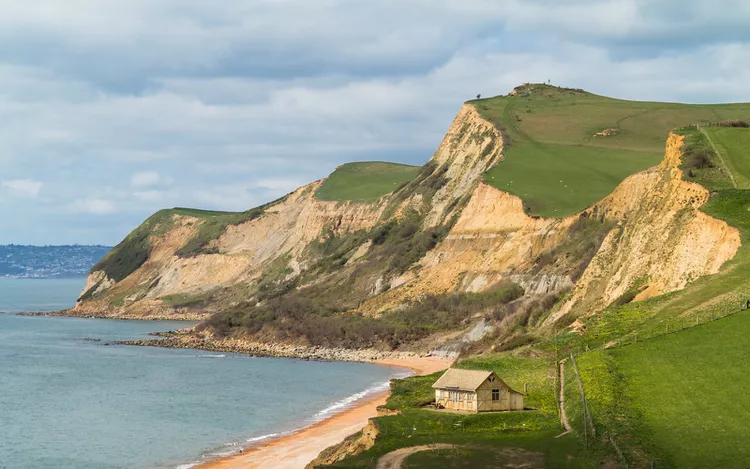Your guide to touring the picturesque getaway that spans three geologic periods.
Imagine England. No, not London or the Royals. Instead, think verdant pastures dotted with sheep, cozy thatch-roofed cottages, and hedge-rowed hills undulating into the distance.
All of that is exactly what you’d see if you stood almost anywhere along England’s Jurassic Coast and looked inland. But turn around, slowly now, and you’ll see the pastures and hedgerows end abruptly — really, startlingly — at the edge of a craggy wall of red-rocked, 150-foot cliffs that drop straight down to a pristine beach.
Look east down the beach through a pair of binoculars, and you’ll see wetsuit-wrapped surfers riding the waves. Look farther still, and you’ll see aquamarine waters lapping against the base of a natural stone arch as spectacular as anything in Mexico or the Caribbean.
While it’s just a three-hour road trip from London, England’s Jurassic Coast is a place few Americans have ever heard of, despite its designation as a UNESCO World Heritage Site. And, while you could spend months exploring the beaches, towns, cliffs, and walking trails, this is your guide to a leisurely driving tour of the best this beautiful stretch of coastline has to offer.
1. Old Harry Rocks

Your first stop along the coast should be Old Harry Rocks, a collection of dramatic white-chalk cliffs that plunge into the English Channel near the far eastern edge of the county of Dorset. A mere 66 million years old, these cliffs are the youngest the Jurassic Coast has on offer. (“Jurassic Coast” is actually a bit of a misnomer. The geology of this English coastline spans the Triassic, Jurassic, and Cretaceous periods — or roughly 185 million years of geologic history. The farther west you move along the coast, the older the rocks.)
If you park your car in Studland or Swanage, Old Harry Rocks is a short, 15-minute walk away. (The English love a good hike, and many of the country’s most beautiful sights are only accessible on foot.) Seen from the water, the contrast between the cliffs and the surrounding landscape is striking.
2. Durdle Door and Man O’War Beach

A leisurely 40-minute drive west from Swanage brings you to Durdle Door, the most iconic (and Instagram-worthy) of the Jurassic Coast’s natural wonders. If you’re lucky enough to catch these beaches on a sunny day, the water is a stunning turquoise and the rocks seem to glow.
Again, you’ll need to walk a half-mile from the Durdle Door parking area to reach the beach — and you’ll want to set aside a few hours at least for your visit. Swimming and sunbathing are big here in summer. The rest of the year, this whole section of coastline is worth hiking. You could also visit nearby Tyneham — a “ghost village” abandoned since World War II.
3. Weymouth and Chesil Beach

One of the most popular and populated towns along the Jurassic Coast, Weymouth is a three-season haven for surfers, swimmers, kiteboarders, and other water-sports enthusiasts. You could spend a day or two at least in this town, grabbing lunch at beachside hangout or exploring the lighthouse and other sights on the Isle of Portland.
Weymouth also marks the starting point of Chesil Beach, a breathtaking shore stretching 18 miles up the coastline. Famed for its beauty and its billions of rocks, which clatter together soothingly as the waves hit the shore, Chesil Beach is a walker’s paradise.
4. West Bay and Bridport

Bridport is a bustling inland town with a fine outdoor street market that operates year-round on Wednesday and Saturday mornings. From books to antiques, it’s a great place to grab breakfast or lunch and a few souvenirs.
A short drive will bring you to West Bay, a coastal hamlet that marks the start of the jaw-dropping but unstable bluff of East Cliff. Like a landscape from Game of Thrones, East Cliff rises up from the western end of Chesil beach, allowing you to walk along it and marvel at its 175-million-year-old striations.
5. Lyme Regis

The setting for both “The French Lieutenant’s Woman” and “Ammonite,” Lyme Regis is a popular summer getaway for sun-starved English vacationers. A restaurant- and shop-lined boardwalk spans the historic town’s naturally sheltered beach, which is a dream for swimmers and a world-renowned spot for fossil hunters. Even the inexperienced are likely to find the 200-million-year-old shells of ammonites (extinct ancestors of mollusks) embedded in the rocks along the shore.
A short drive inland from Lyme Regis brings you to the charming town of Axminster and the River Cottage, an excellent restaurant and estate made famous by the award-winning English television program Escape to River Cottage, hosted by Hugh Fearnley-Whittingstall. Brunch at the notoriously quirky Rousdon Kitchen in nearby Devon is another must for out-of-towners.





